Vaccination and the History of Smallpox Eradication- Lec 24
1/130
There's no tags or description
Looks like no tags are added yet.
Name | Mastery | Learn | Test | Matching | Spaced |
|---|
No study sessions yet.
131 Terms
What is the primary purpose of vaccines?
Vaccines are preventative in nature and must be applied prior to showing symptoms of disease, preferably before infection occurs.
What phenomenon do vaccines exploit to provide immunity?
Vaccines exploit the phenomenon of immune memory.
What is the historical significance of smallpox vaccination?
Smallpox vaccination is considered an archetype of successful immunization.
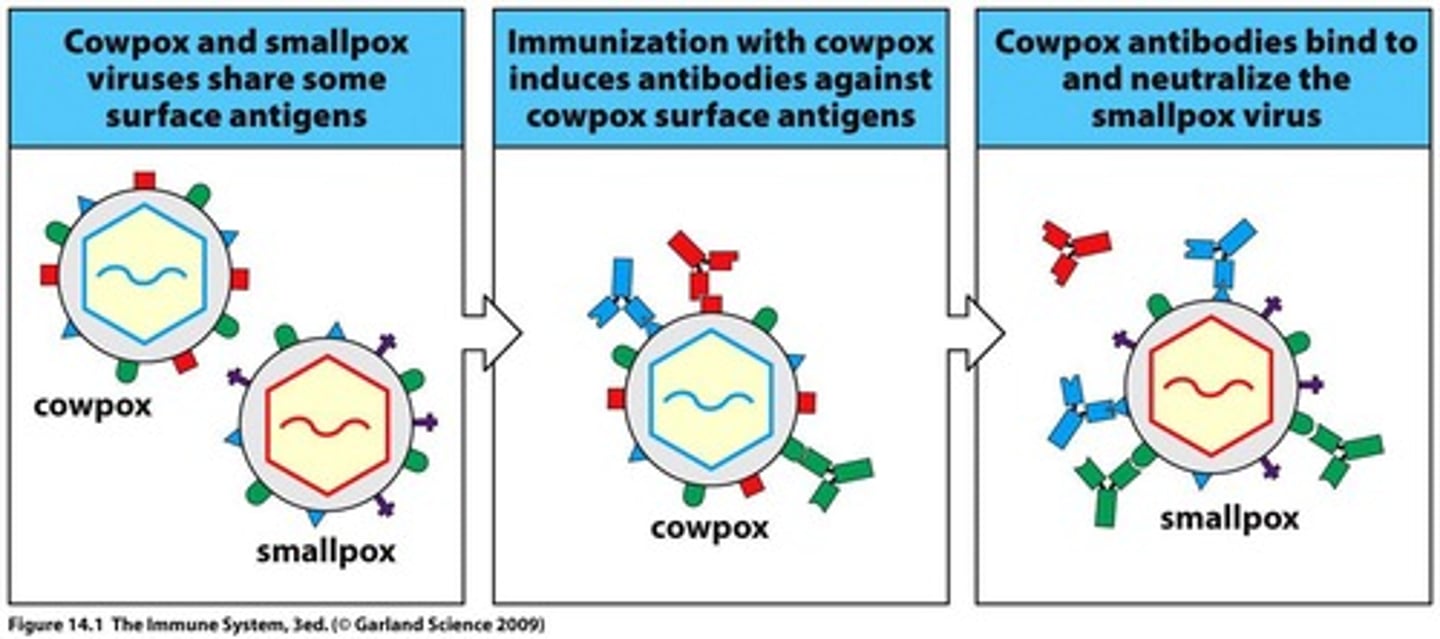
What are the two strains of the Variola virus that cause smallpox?
Variola major, which causes a severe form, and Variola minor, which causes a generally less severe form.
What was the mortality rate of smallpox in European populations?
Smallpox killed about 30% of those infected in European populations.
What was the mortality rate of smallpox in populations not previously exposed?
In populations not selected by centuries of exposure, the mortality rate could exceed 75%.
What ancient evidence suggests the existence of smallpox?
3000-year-old Egyptian mummies provide some direct physical evidence of smallpox infection.
Who was Muhammad ibn Zakariya ar-Razi and what was his contribution to the understanding of smallpox?
He distinguished smallpox from other diseases in the 9th century.
What is variolation and where did it originate?
Variolation is a practice that developed in China or India around 800-900 CE, involving the introduction of material from healing pustules to induce a mild infection.
How did variolation differ from natural smallpox infection?
Variolation caused less severe disease due to the selection of the less virulent V. minor and the method of inoculation, which was not the natural route of infection.
Who introduced the practice of variolation to England?
Lady Mary Wortley Montagu introduced variolation to England after observing it in the Ottoman Empire.
What was the outcome of successful variolation?
Successful variolation would result in a mild form of the disease, leading to immunity against smallpox.
What were the overt clinical manifestations of smallpox?
The notes do not specify, but smallpox typically included fever, body aches, and a characteristic rash.
What role did smallpox play in the decimation of native populations in the New World?
Smallpox was instrumental in decimating native populations when they came into contact with Europeans.
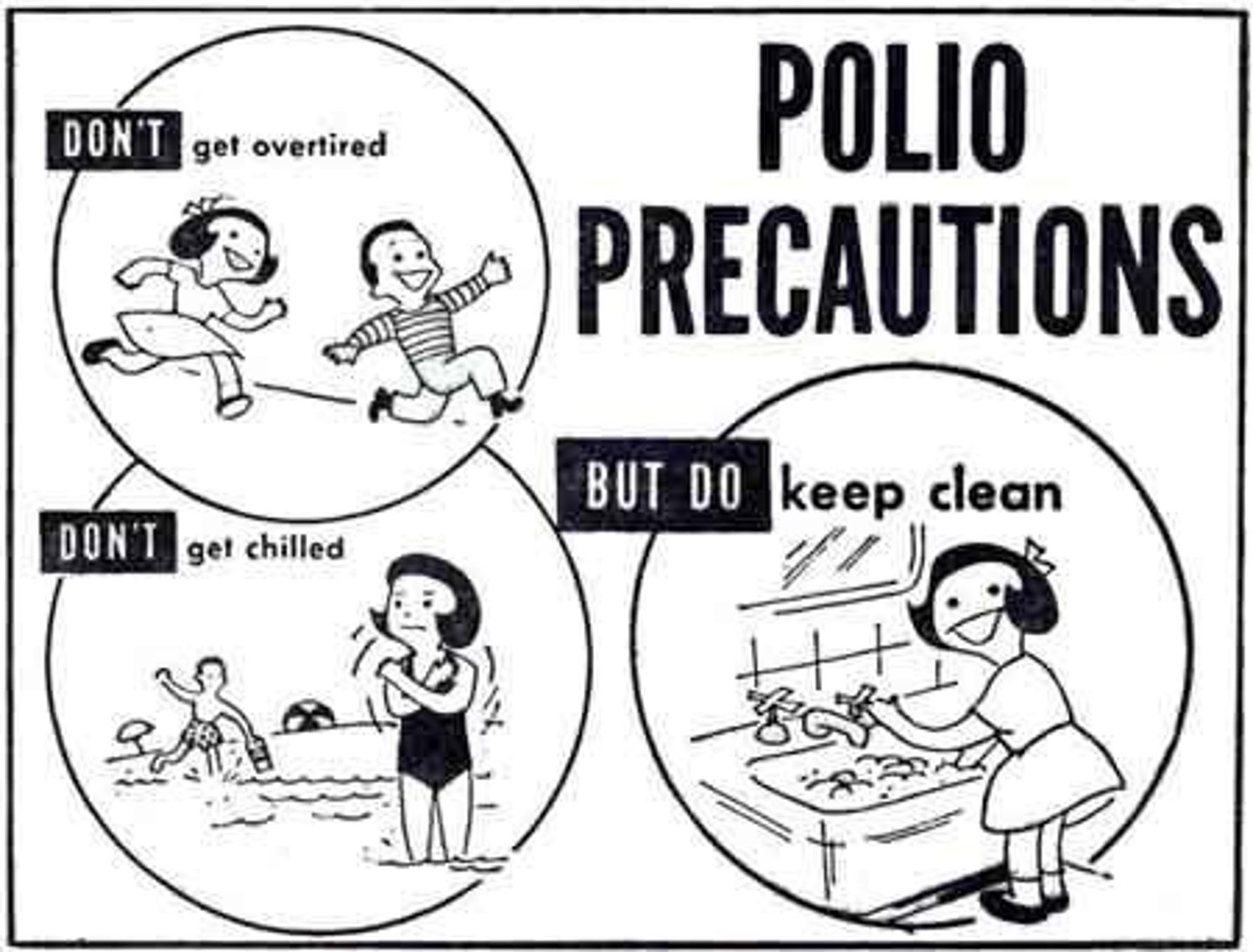
What is the significance of immune memory in vaccination?
Immune memory allows the immune system to recognize and respond more effectively to pathogens upon subsequent exposures.
What is the most cost-effective medical procedure ever devised?
Vaccination is considered the single most cost-effective medical procedure.
What is necessary for a successful vaccine?
The notes do not specify, but generally, a successful vaccine must be safe, effective, and provide long-lasting immunity.
What are vaccine adjuvants?
The notes do not specify, but adjuvants are substances added to vaccines to enhance the immune response.
What historical accounts make it difficult to distinguish smallpox from other diseases?
Early historical accounts often confused smallpox with measles and chickenpox.
What was the impact of smallpox in the Middle Ages?
Smallpox became endemic in Europe, killing hundreds of thousands.
What was the method of inoculation in variolation?
Inoculation was done by introducing dried materials through the nostrils or by abrading the skin.
What was the outcome of the test performed on condemned prisoners in Newgate prison regarding variolation?
All prisoners survived, convincing the nobility to adopt the practice.
Who was variolated by the Prince of Wales in 1722?
His own children.
What was the significance of Edward Jenner's observation about milkmaids and smallpox?
Milkmaids seldom got smallpox, likely due to previous infection with cowpox.
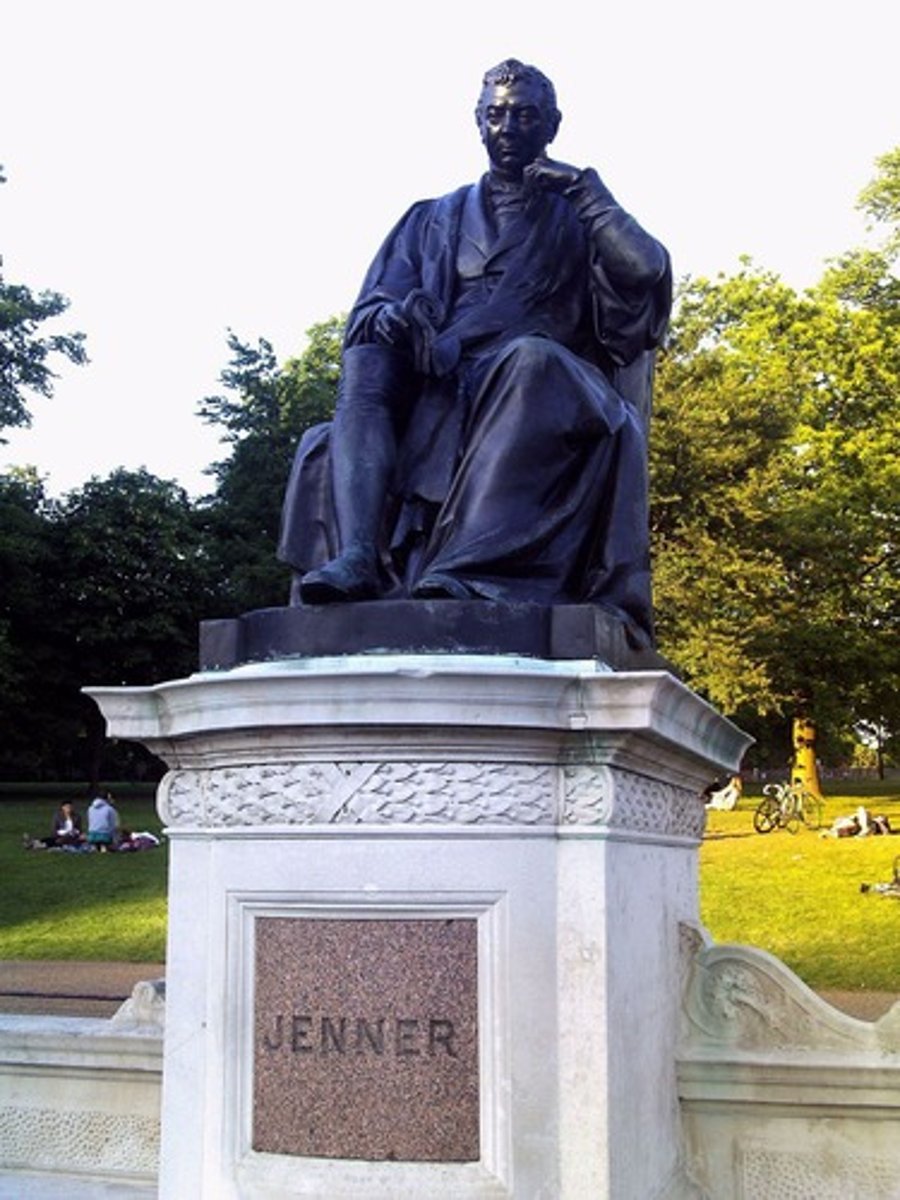
What disease did Edward Jenner use to protect against smallpox?
Cowpox.

What was the date when Edward Jenner introduced cowpox to James Phipps?
14 May 1796.
What was the outcome of Jenner's experiment on James Phipps after exposure to smallpox?
James developed a mild illness and recovered.
What are the two viruses associated with smallpox and cowpox?
Smallpox virus is Variola virus; Cowpox virus is vaccinia virus.
What was the World Health Organization's goal in 1967 regarding smallpox?
To eradicate smallpox through mass vaccination.
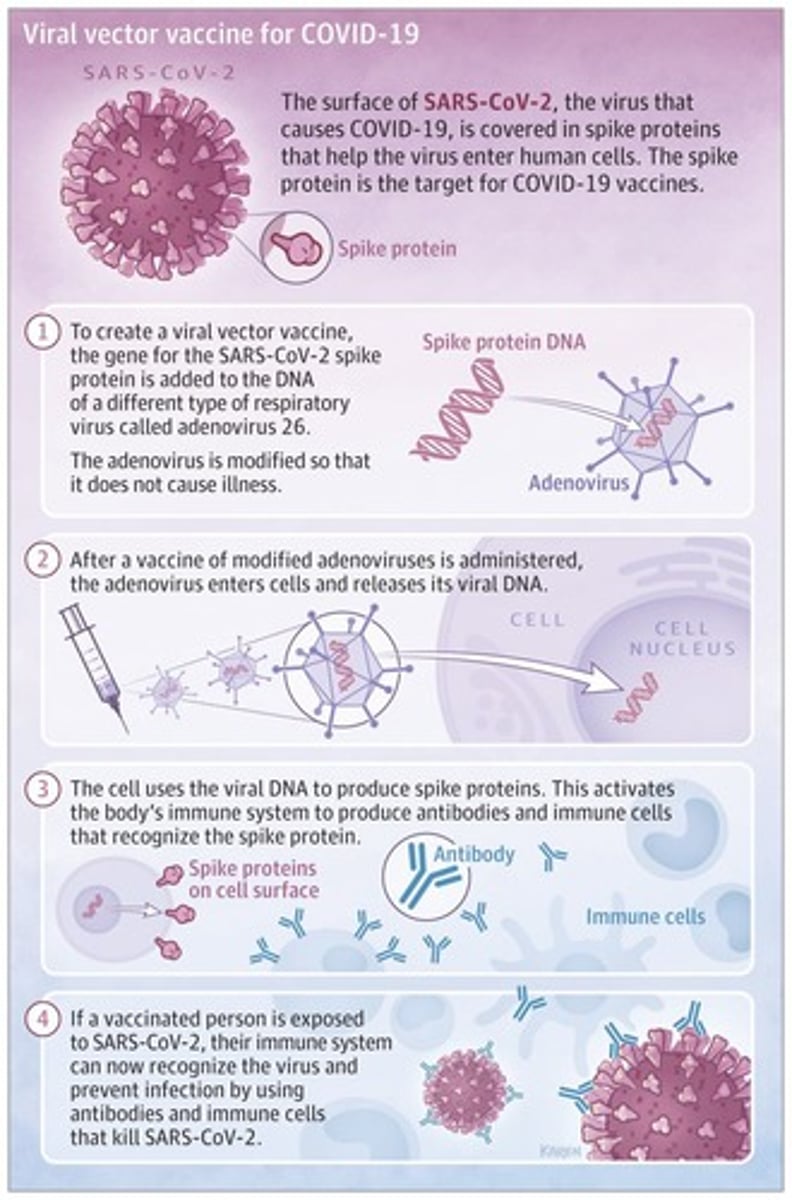
Who was the American in charge of the WHO smallpox eradication program?
Donald Henderson.
When was the declaration of smallpox eradication signed?
1979
What principle of immunization did Jenner's work demonstrate?
Artificial exposure to an infectious agent can protect against natural exposure.
Why can't Jenner's specific strategy of vaccination be used on most other pathogens?
It relies on using a naturally-occurring 'safe' strain, which is not available for most pathogens.
What was Louis Pasteur's contribution to microbiology?
He showed that microorganisms cause the spoiling of beer, wine, and milk, and founded the germ theory of infection.
What disease did Pasteur study that was economically important to chickens?
Chicken cholera.
What mistake did Pasteur's assistant, Charles Chamberlain, make during the chicken cholera experiment?
He used old bacterial cultures that had been sitting around for a month instead of fresh cultures.
What was the result of using old bacterial cultures on the chickens?
The chickens either did not get ill or had very mild disease.
What did Pasteur want to do with the old bacterial cultures after Chamberlain's mistake?
He wanted to save the chickens and the old cultures.
What was the legacy of Jenner's work in immunization?
It established the principle of using controlled exposure to prevent serious disease.
What was the last recorded case of smallpox?
The last cases of Variola major and minor were recorded in the late 1970s.
What was the hide of the cow used in Jenner's experiment?
The cow's hide hangs in the library at St. George's Medical School.
What happened to Sarah Nelmes after Jenner's experiment?
Nobody heard from her again.
What is the Latin origin of the word 'vaccinia'?
Vacca, meaning 'cow'.
What principle did Pasteur use to create vaccines against various agents?
The principle of attenuation, which involves weakening pathogens so they provoke immune responses without causing severe disease.
How did Pasteur develop the first rabies vaccine?
By serially passaging the rabies virus through the brains of rabbits.
What was the significance of Joseph Meister's vaccination?
Pasteur vaccinated him after he was mauled by a rabid dog, preventing disease and certain death.
What are the five general strategies for making vaccines against viral pathogens?
1) Killed (inactivated) vaccines, 2) Attenuated vaccines, 3) Subunit vaccines, 4) Hybrid vaccines, 5) Nucleic acid vaccines.
What is the process for creating inactivated vaccines?
Pathogenic viruses are grown in large numbers and treated with formalin, high temperature, or irradiation to render them non-infectious.
What are the drawbacks of inactivated vaccines?
They require facilities for growing pathogenic viruses, may not induce as strong an immune response as live viruses, and can induce qualitatively different immune responses.
What is the process of attenuation in live vaccines?
The virus is grown under unnatural conditions, leading to adaptive changes that render it incapable of causing disease in the original host.
What is an advantage of live attenuated vaccines?
They tend to induce stronger, potentially local immunity.
How can viruses be adapted for live attenuated vaccines?
By growing them at lower temperatures to adapt to conditions outside the normal body temperature.
What is the strategy behind subunit vaccines?
Using an isolated part of an infectious agent as the vaccine material.
What is the current vaccine against Hepatitis B virus (HBV) made from?
It is made using recombinant DNA technology, specifically the viral surface protein (HBs).
What is the effectiveness of the Hepatitis B vaccine?
It provides protection in 85-90% of vaccinated individuals for up to 25 years.
What is a major advantage of subunit vaccines?
Primarily safety, as they are far removed from the pathogen and non-infectious.
What is a disadvantage of subunit vaccines?
They have little chance of generating cell-mediated or local immunity.
What does the term 'attenuated' refer to in vaccine development?
It refers to a process of weakening a virus so that it can provoke an immune response without causing disease.
Why might killed vaccines not induce as powerful an immune response as live vaccines?
Killed viruses may not replicate the natural infection process, which can lead to a weaker immune response.
What is the role of formalin in the production of inactivated vaccines?
Formalin is used to treat viruses, rendering them non-infectious.
What are hybrid vaccines?
Hybrid vaccines combine elements from different types of vaccines to enhance immune response.
What is the risk associated with growing large amounts of pathogenic virus for vaccine development?
There is an opportunity for accidental exposures to the pathogenic virus.
What is the significance of the term 'nucleic acid vaccines'?
Nucleic acid vaccines involve using genetic material to provoke an immune response.
How does exposure to a live virus differ from exposure to a killed virus in terms of immune response?
Live viruses can induce a more robust and localized immune response compared to killed viruses.
What is the historical context of Pasteur's work in relation to vaccination?
Pasteur's techniques generalized the concept of immunization beyond smallpox, allowing for the development of vaccines for various diseases.
What are purified components lacking that necessitate the use of adjuvants?
TLR ligands to activate innate immunity.
What is the purpose of hybrid vaccines?
To expose the immune system to a critical component of a pathogenic organism, such as a viral attachment protein, using a harmless vector.
How does a hybrid vaccine generate immunity?
By inoculating a recipient with a hybrid virus that expresses a transgene from the pathogen, provoking an immune response.
What is an example of a hybrid vaccine?
The Johnson & Johnson Covid-19 Vaccine.
What critical protein does the Johnson & Johnson Covid-19 Vaccine target?
The Covid surface 'spike' protein.
What vector is used in the Johnson & Johnson Covid-19 Vaccine?
A genetically 'crippled' Adenovirus 26 vector.
What are the advantages of hybrid vaccines?
Stronger, longer-lasting immunity and potential for local immune responses if the target pathogen and vector share similar tissue tropism.
What is a disadvantage of hybrid vaccines?
Pre-existing immunity to the viral vector can interfere with generating immunity against the transgene.
What do nucleic acid vaccines identify from pathogens?
Vital components such as viral attachment proteins or bacterial toxins.
What is the method of delivering nucleic acids in nucleic acid vaccines?
Using cationic lipids or gold nanoparticles.
What is an example of a nucleic acid vaccine?
The Moderna Covid-19 mRNA vaccine.

What are the advantages of nucleic acid vaccines?
They can generate humoral and cell-mediated immunity, and synthetic mRNA can be recognized by TLR 7/8.
What are the disadvantages of nucleic acid vaccines?
DNA may not be suitable for humans due to the risk of genome integration, and mRNA is labile and requires extremely cold storage.
What is poliomyelitis commonly known as?
Infantile paralysis.
What type of virus is poliovirus classified as?
A picornavirus, which is a small RNA virus.
How many strains of poliovirus are there?
Three strains: PV1 (Mahoney), PV2 (Lansing), and PV3 (Leon).
How is poliovirus primarily transmitted?
Through ingestion of contaminated water.
Where does poliovirus first replicate in the body?
In the lymphoid tissues of the pharynx and/or gut.
What can occur if a viremia state is established by poliovirus?
The virus may gain access to the central nervous system, leading to paralytic disease.
What type of immunity protects against poliovirus?
Antibody-mediated immunity (IgA or IgG).
Who was significantly affected by poliovirus in the US history?
Franklin D. Roosevelt (FDR), who lost effective use of his legs due to the disease.
Who developed the first polio vaccine?
Jonas Salk.
What virus strains were used in the Salk vaccine trials?
Three strains of poliovirus grown in VERO cell line (African Green Monkey).
What was the effectiveness of the Salk vaccine against the three poliovirus strains?
60-70% effective against PV1, 90% effective against PV2, and 92% effective against PV3.
What was the trend in polio cases in the US from 1953 to 1961?
Polio cases decreased from 35,000 in 1953 to 161 in 1961.
What type of vaccine did Albert Sabin develop in 1958?
A live attenuated vaccine.
How does the Sabin vaccine achieve attenuation?
Through serial passage in non-human primate cells cultured at sub-physiological temperatures.
What is the significance of nucleotide differences between wild poliovirus and vaccine strains?
57 differences for PV1, 10 for PV3, and only 2 for PV2, indicating varying levels of genetic change.
What is the protection rate provided by three doses of the Sabin vaccine?
95% protection for all strains.
What are the advantages of the Sabin vaccine over the Salk vaccine?
Produces stronger, longer-lasting immunity, local mucosal immunity with secretory IgA, and easier mass vaccination.
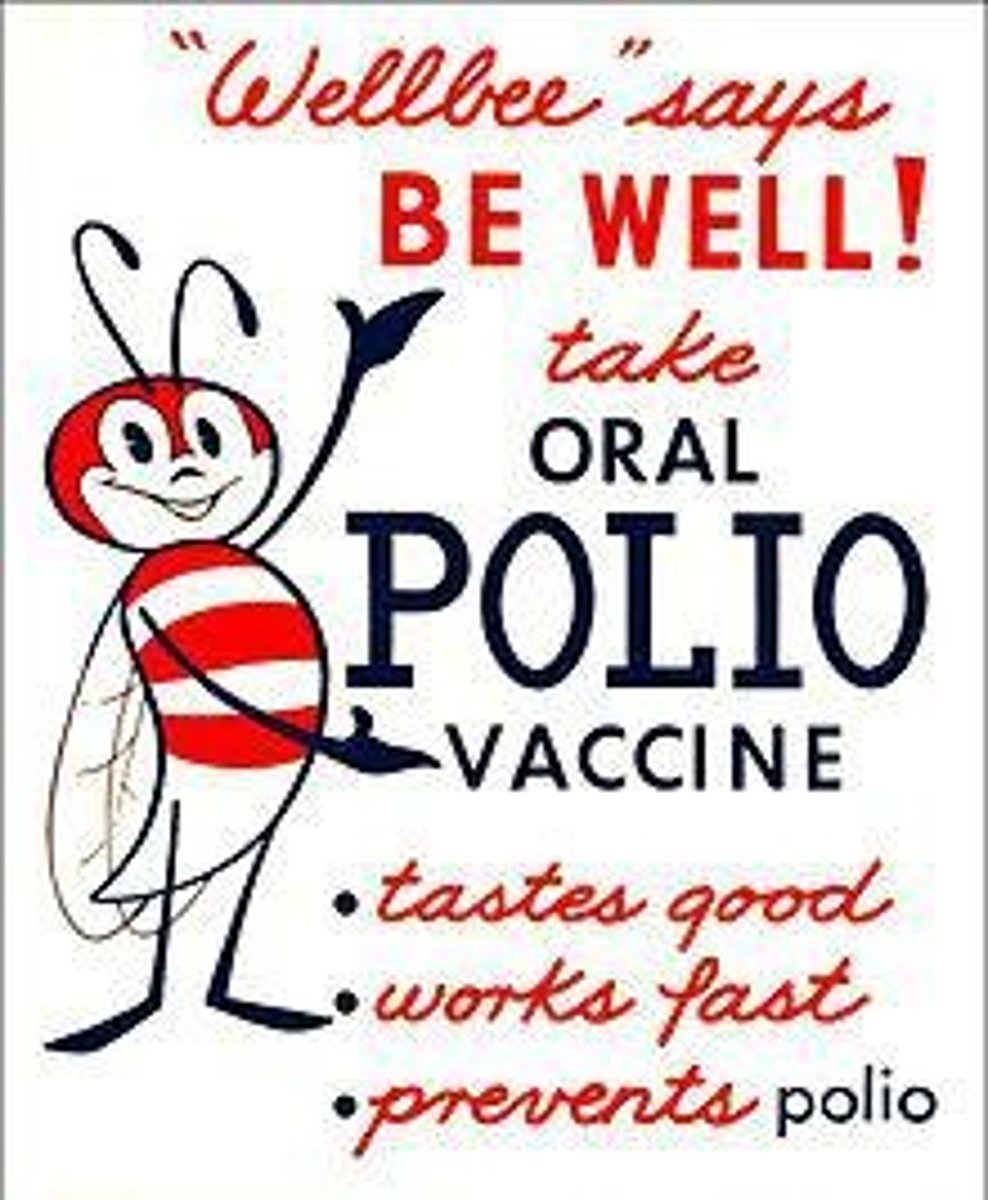
What is a potential risk associated with the Sabin vaccine?
Spontaneous reversion can occur, leading to vaccine-derived polio (rare, about 1 in 750,000).
What is the current status of polio globally as of the notes?
Polio is endemic in only 2 countries: Pakistan and Afghanistan.
What is the BCG vaccine used for?
It is an attenuated vaccine against Mycobacterium tuberculosis.
Why is the BCG vaccine not given in the US?
It is not considered effective enough compared to other tuberculosis control measures.
What is the purpose of anti-toxin vaccines?
To generate antibodies that bind to and neutralize specific bacterial toxins.